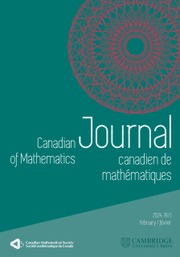Crossref Citations
This article has been cited by the following publications. This list is generated based on data provided by Crossref.
Shioda, Tetsuji
1981.
Algebraic cycles on abelian varieties of fermat type.
Mathematische Annalen,
Vol. 258,
Issue. 1,
p.
65.
Waldschmidt, Michel
1982.
Number Theory Related to Fermat’s Last Theorem.
Vol. 26,
Issue. ,
p.
79.
Aoki, Noboru
1983.
On some arithmetic problems related to the hodge cycles on the fermat varieties.
Mathematische Annalen,
Vol. 266,
Issue. 1,
p.
23.
Wolfart, J�rgen
and
W�stholz, Gisbert
1985.
Der �berlagerungsradius gewisser algebraischer Kurven und die Werte der Betafunktion an rationalen Stellen.
Mathematische Annalen,
Vol. 273,
Issue. 1,
p.
1.
Hindry, Marc
1988.
Autour d'une conjecture de Serge Lang.
Inventiones Mathematicae,
Vol. 94,
Issue. 3,
p.
575.
Wolfart, J�rgen
1988.
Werte hypergeometrischer funktionen.
Inventiones Mathematicae,
Vol. 92,
Issue. 1,
p.
187.
Mai, Liem
1989.
Lower bounds for the ranks of CM types.
Journal of Number Theory,
Vol. 32,
Issue. 2,
p.
192.
Coleman, Robert F.
1989.
Torsion points on abelian étale coverings of 𝑃¹-{0,1,∞}.
Transactions of the American Mathematical Society,
Vol. 311,
Issue. 1,
p.
185.
Koblitz, Neal
1990.
Advances in Cryptology — CRYPTO’ 88.
Vol. 403,
Issue. ,
p.
94.
Lim, Chong Hai
1992.
The jacobian of a cyclic quotient of a fermat curve.
Nagoya Mathematical Journal,
Vol. 125,
Issue. ,
p.
73.
Ruelle, Ph.
Thiran, E.
and
Weyers, J.
1993.
Implications of an arithmetical symmetry of the commutant for modular invariants.
Nuclear Physics B,
Vol. 402,
Issue. 3,
p.
693.
Prapavessi, Despina T.
1994.
On the Jacobian of the Klein curve.
Proceedings of the American Mathematical Society,
Vol. 122,
Issue. 4,
p.
971.
Gannon, Terry
1995.
Symmetries of the Kac-Peterson modular matrices of affine algebras.
Inventiones Mathematicae,
Vol. 122,
Issue. 1,
p.
341.
Gannon, Terry
and
Walton, Mark A.
1995.
On the classification of diagonal coset modular invariants.
Communications in Mathematical Physics,
Vol. 173,
Issue. 1,
p.
175.
Lim, Chong -Hai
1995.
The Shafarevich-Tate group and the Jacobian of a cyclic quotient of a Fermat curve.
Archiv der Mathematik,
Vol. 64,
Issue. 1,
p.
17.
Adler, Allan
1997.
Eisenstein and the Jacobian Varieties of Fermat Curves.
Rocky Mountain Journal of Mathematics,
Vol. 27,
Issue. 1,
Ruelle, P.
and
Verhoeven, O.
1998.
Discrete symmetries of unitary minimal conformal theories.
Nuclear Physics B,
Vol. 535,
Issue. 3,
p.
650.
Altschüler, D
Ruelle, P
and
Thiran, E
1999.
On parity functions in conformal field theories.
Journal of Physics A: Mathematical and General,
Vol. 32,
Issue. 19,
p.
3555.
Gannon, Terry
2000.
The Level 2 and 3 Modular Invariants for the Orthogonal Algebras.
Canadian Journal of Mathematics,
Vol. 52,
Issue. 3,
p.
503.
Tzermias, Pavlos
2003.
Low-degree points on Hurwitz-Klein curves.
Transactions of the American Mathematical Society,
Vol. 356,
Issue. 3,
p.
939.



